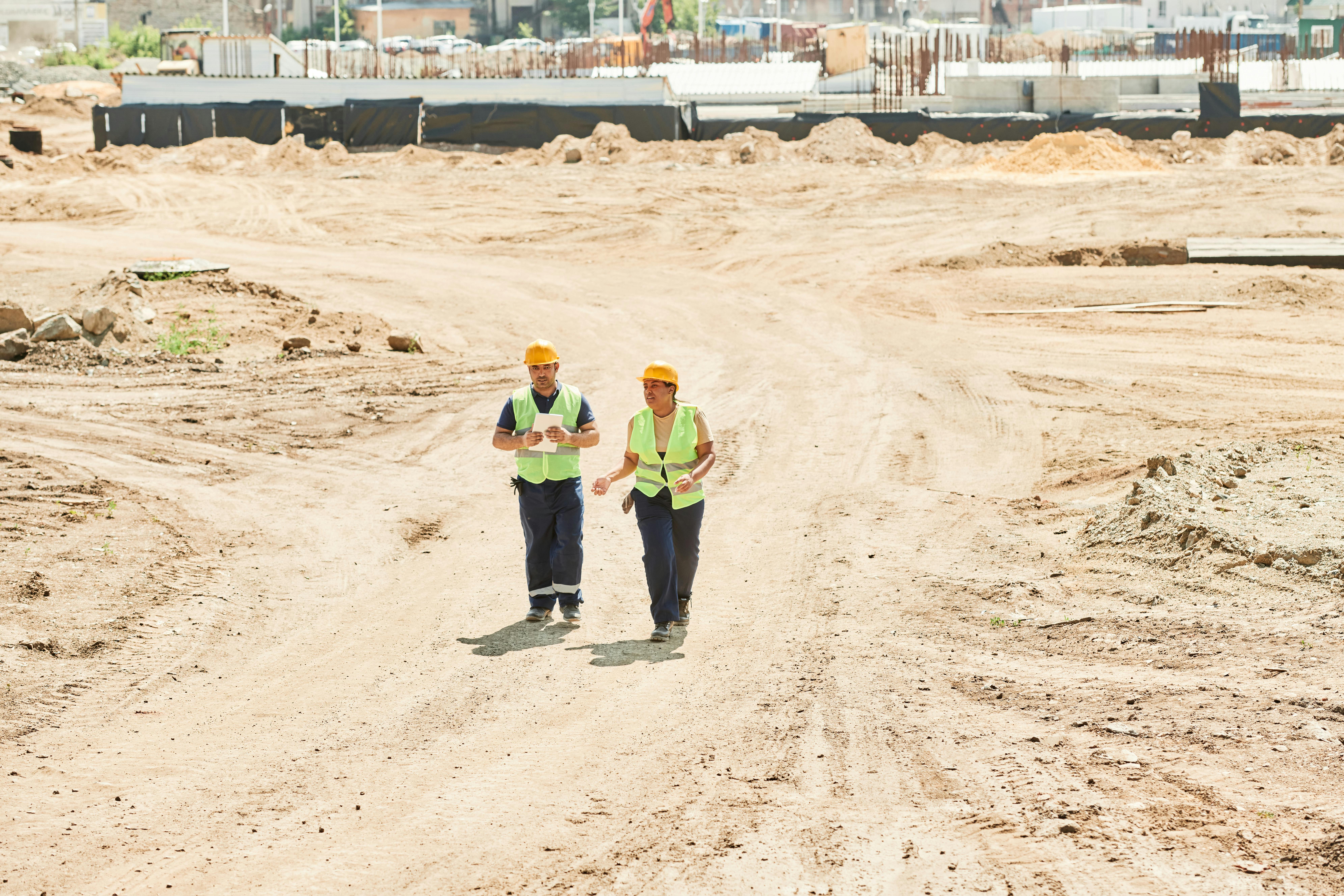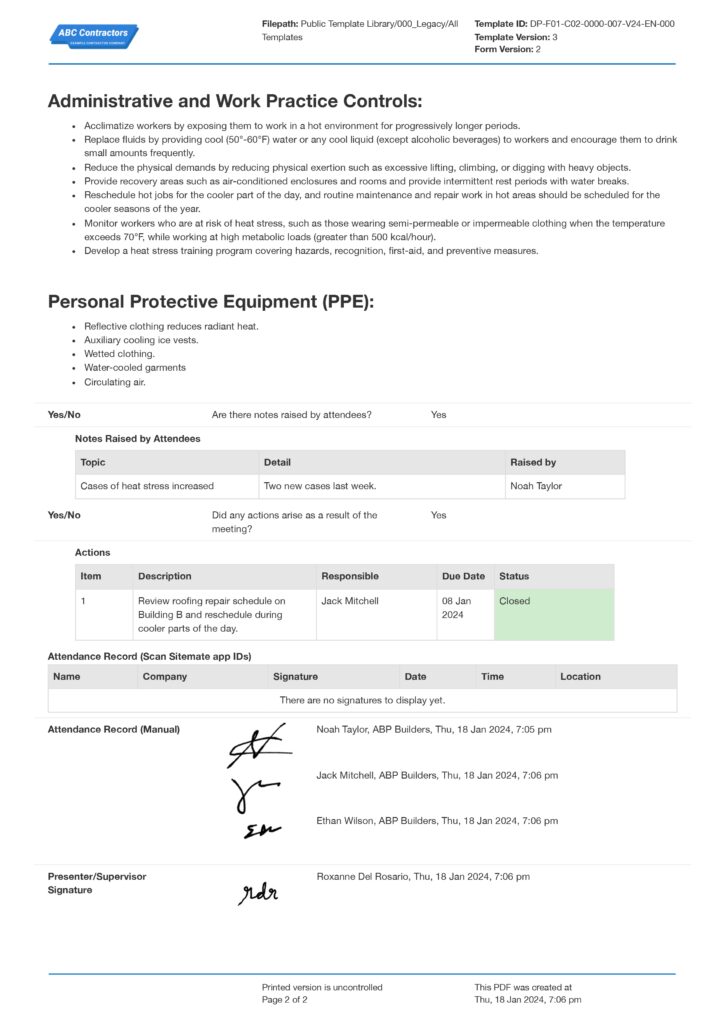Dashpivot Article – Heat Stress Management
Heat Stress Management
Heat stress is a workplace hazard, and OH&S and OSHA protect workers from its effects. This article explores the regulations, symptoms, best practices and preventive measures, and digital solutions for heat stress prevention.

Understanding The Main Causes and Effects of Heat Stress
Understanding the causes and effects of heat stress is important to implement prevention strategies aligned with the regulations set in OH&S.
Heat stress is experienced among workers who cannot regulate their temperature due to prolonged heat exposure, ultimately leading to dehydration, dizziness, fatigue, and in the most severe cases heat stroke. Workers who are most at risk of heat stress are those working in the construction, agriculture, and manufacturing industries because of environmental, physical, and work-related factors. Below are the main causes and effects of heat stress.
What are the Main Causes of Heat Stress Affecting Workers?
Extreme heat is a major contributor to heat stress, especially when the workers are exposed under the sun for a long time. Heat and humidity make it difficult for the body to release heat through sweating. With high humidity, that means the body isn’t capable of cooling down effectively.
Construction workers work under the direct sunlight, like for example on high-rise buildings or projects, and they don’t get enough shade while working for 8–12 hours a day. Although their bodies have become accustomed to the heat exposure and their tolerances have increased, they’re still prone to the severe consequences of heat stress.
Manufacturing workers face a different kind of challenges compared to construction workers because they mostly work indoors, but the working environment is still harsh and prone to heat stress. They don’t deal with sun exposure, but they are exposed to heat in factories, chemicals, and fumes and dust.
Strenuous physical exertion, especially with construction, agriculture, and manufacturing workers are part of their jobs, and this further raises the body temperature because of internal heat. Mixing both internal heat and external heat, this eventually leads to dehydration and exhaustion.
Construction workers engage in heavy lifting, climbing, operating machineries, and digging, which generate body heat, and with repetitive work, they may feel weak and lose coordination, increasing the risks of accidents. Adding internal heat from physical labour with external heat can cause even further and more severe consequences of heat stress.
Manufacturing workers operate machineries, do repetitive motions, and stand for long hours. All of these generate heat which make the workplace even hotter.
Dehydration is another major cause that worsen the consequences of heat stress. Water is extremely helpful in enabling sweat production, and regulating the internal body temperature. When the body doesn’t have enough fluids, it leads to fatigue, dizziness, and heatstroke.
Both construction and manufacturing workers face high risks of dehydration because of heat exposure, limited cooling and hydration breaks, and physical exertion.
What are the Main Effects of Heat Stress Among Workers?
Heat stress extremely affects workers across many industries, most especially those in heat-exposed and physically laborious industries like the construction, agriculture, manufacturing industries, oil and gas, mining, and others. The main causes of heat stress in these industries are the high temperatures of the environment they work in, lack of hydration, lack of ventilation, prolonged exposure to external and internal heat, humidity, and more, and these industries have more than one present affecting workers day to day.
With daily exposure, workers experiencing heat stress could possibly have a slower reaction time, and if they’re dealing with machines and equipment, they are high chances of workplace accidents. Productivity isn’t just an issue to deal with as an effect of heat stress, but also the well-being of the workers. Workers need to be alert and awake to avoid incidents and accidents in the workplace, but that’s less likely if they’re already experiencing the severe effects and symptoms of heat stress. Without preventive measures like cooling breaks and scheduled works initiated by employers, the result is going to be more than just reduced productivity, it can cause long-term health issues, and worse, fatalities.
Common Symptoms of Heat Stress in Some Industries
The construction industry is one of the hottest, not necessarily the hottest, industries around, not for a good reason, but for the bad one. Other industries can be just as hot, if not more. In this physically laborious industry, construction workers work under the direct sun for more than 8 hours a day, and on top of that, they're doing strenuous physical activities, making them more likely harmed to heat stress and its extreme symptoms. The most common symptoms they experience are excessive sweating due to their long-sleeved protective clothing and PPE, dizziness due to a combination of factors, fainting due to reduced blood circulation, and overheating due to many reasons and combined factors. They could have heat rash from too much sweat under their personal protective equipment, muscle cramps from electrolyte loss, and irritability as heat exhaustion impairs cognitive functions.
Manufacturing workers, on the other hand, are exposed to indoor heat from machines, lack of ventilation, and repetitive physical labour, but they also show similar symptoms to construction workers like excessive sweating, fainting, and overheating. Oxygen levels drop especially in enclosed manufacturing spaces, meaning there’s lack of fresh air circulation. This can lead to fatigue, sluggishness, lack of concentration and coordination, headaches, and skin burns are also one of the common symptoms among manufacturing workers. In addition to that, there are also airborne contaminants because most manufacturing processes release dust, fumes, and chemical vapors. It’s a different kind of battle manufacturing workers deal with daily, because with a lack of ventilation, pollutants also remain in the air. So they’re not just dealing with the consequences of heat stress, but also long term respiratory issues, and eye irritation.
Agricultural workers experience harsh symptoms since they spend more hours under direct sunlight and sometimes in humid conditions. Just a recap, humidity affects the body’s ability to cool itself through heating, meaning agricultural workers are most vulnerable when it comes to the heat stress effects caused by humidity because of the type of environment they work in. They spent many hours outdoors, and they experience extreme dehydration, due to lack of water intake for hours and insufficient cooling and water-drinking station. They also experience painful muscle spasms or heat cramps due to intense physical labour electrolyte loss, and excessive swearing. Furthermore, fluid loss causes nausea and vomiting as part of heat exhaustion. With too much sun exposure and lack of protective gears, they may also result in sunburns and heat rashes. Sunburns may not be permanent, but repeated exposure definitely causes long-term damage to the skin like skin discolouration, increased risk to skin cancer, scars, and aging. Skin rashes, too, are not permanent, but can lead to other permanent effects like hyperpigmentation, skin infections, and chronic skin irritation. Heat syncope, is also one of the symptoms of heat stress, which happens when blood pressure suddenly drops, there’s not enough blood from standing too long under the sun.
The risks, effects, and symptoms of heat stress to workers in many industries may somehow vary and differ, but they're still life-threatening that can cause long-term health conditions if not addressed immediately. There is no better or worse heat stress management across industries, because heat stress is a world-wide concern and not a competition on which ones have fewer workers dealing with it. No one should ever have to deal with it, or even risk their lives for productivity. Yes, economic growth is more important and workers are just trying to make a living, but employers should be reminded that their workers are humans and humans are not dispensable like objects. The welfare of the workers is key to having a successful business. An organisation can be largely judged based on how they treat their employees, and they make the workplace safe and healthy.
Preventing heat stress is a combined initiative that must be taken by employers, the whole industry, and the workers themselves. There should be enough cooling and hydration stations, most especially in wide work areas, like the agriculture industry. Workers must never forget to drink water during these breaks, replenish fluids, and follow the heat stress prevention initiatives set by the employers. It’s also the workers' responsibility to provide feedback and voice out their concerns if they think their well-being is not being prioritised. For indoor settings, like the manufacturing industry, there must be adequate ventilation to regulate indoor temperatures and remove dusts and fumes from chemicals. Employers must schedule rests and breaks so that workers can recover from the repetitive tasks they do for hours and hours. Additionally, businesses in all industries must mandate heat stress safety training and programs so that workers can recognise the early symptoms and take preventive actions before conditions worsen.
It’s really a collective effort, that’s why OH&S has provided guidelines to manage heat stress, and OSHA has also suggested a Heat Illness Prevention Program to make it easier to address and prevent heat stress.
OH&S Heat Stress Management Guidelines and OSHA’s Heat Illness Prevention Program
The Occupational Health & Safety (OH&S) has set proactive measures that prevent heat stress among workers and protect them from short and long-term heat-related illnesses. The guidelines focus on risk assessment, engineering controls, administrative policies, and personal proactive measures. And to summarise, the guidelines were mainly created to prevent heat-related illnesses among all employees, contractors, and visitors, so it’s also their responsibility to follow through the guidelines, and for the businesses to enforce these guidelines. The employers are fully responsible for setting and implementing the preventive measures, training, and monitoring all of them to ensure they’re effective and relevant all throughout the projects. Supervisors, too, should make sure that the workplace adheres to the safety guidelines as set in OH&S and any other safety regulations. They adjust the workloads to workers, set work blocks, work scheduling, and schedule rest breaks. Workers and employees must follow the rules, regulations, and guides set by the supervisors and the employers. They should make sure to stay hydrated and report any early symptoms as soon as they are recognisable.
To know more, here’s the Heat Stress Guide from OH&S
Meanwhile, the Occupational Safety and Health Administration (OSHA) Standards haven’t actually set specific heat stress regulation, but it does enforce protecting workers through its General Duty Clause, which states that in general workers should be provided a safe and healthy work environment, and obvious that includes protecting them from heat stress-related concerns. Additionally, OSHA has designed a program and a comprehensive approach that protects workers from heat-related illnesses, called Heat Illness Prevention Program. To summarise, it emphasises three core elements: Water, Rest, and Shade.
Water
Employers must provide workers access to water at all times, and workers should drink at least one cup of water every 15–20 minutes. It may be a bit too much to enforce scheduling to drink water, but it’s actually quite helpful since most often people forget to drink water when they’re too focused on their jobs.
Rest
Employers are mandated to make break areas shaded, air-conditions, or equipped with cooling stations, and supervisors should allow frequent breaks throughout the day.
Shade
There should be shaded areas intended for outdoor workers, and there should be proper ventilation for indoor workers. Supervisors should also make sure that the workers take their breaks in shaded areas.
Additional: Acclimation, Training, and Emergency Response
Acclimation means that new or returning workers should gradually increase their tolerance to build exposure. They might not be used to the heat at first so this gradual practice helps them get used to the site. Similarly, there should be rotations on site and a proper balance of heat-exposed and cooler tasks in the workplace.
Employers are mandated to train workers to recognise and identify the early symptoms of heat illness to be able to response accordingly and perform first-aid. Supervisors must also know how to respond to these emergencies, how to perform first-aid themselves, and when to call the authorities and emergency personnel.
Here is a more thorough guide and content of the Heat Illness Prevention Program.
Streamlining Heat Stress Prevention with Digital Tools
Industries have been utilising digital tools to streamline their processes, but sometimes it can be challenging to implement prevention strategies, especially if the industries we’re talking about are dynamic, fast-paced, and workers are constantly on the field with little time to spare. However, digital tools can make things simpler without disrupting productivity. By integrating automation, real-time synchronisation, collaboration, and data-driven insights, employers can actually indirectly prevent heat-related illnesses through digital tools.
Take these OSHA Incident Report App and Smart Incident Report Software, they exist to streamline incident reporting while adhering to OSHA standards and these apps are also customisable to tailor to fit the needs and company regulations of businesses. You can easily and simply add sections that specifically focus on heat stress incidents, so that way, workers can access the apps in their mobile phones or tablets and send out incident reports from everywhere on site once they recognise heat stress symptoms on fellow workers. If this was used in the agriculture industry, and farmworkers are kilometres away from the main office, they can send out reports, take photos, and sync easily with the managers in the officers. Things need to be rushed and addressed immediately, but it’s still key to document accordingly for compliance, audits, and future disputes. Imagine reporting heat-stress related concerns using a paper-based system and the reporter is far away in the office, they’d need to actually drive to the office to send this report. Aside from slowing down productivity, that reporter is at risk of heat stress consequences because they’re out on the field to deliver a report. And even if it is a report has to be submitted at the end of the day, what’s the point of an incident report if there’s no sense of urgency?
With digital incident reports, employers can immediately respond to incidents as soon as they are reported and perform first-aid or emergency response. Data is synced from the workers' phones to the desktops in the office.
Additionally, since data are stored in the cloud, they’re easily retrievable, allowing business to use historical data to identify trends, improve their safety measures, and reduce liabilities. That way, they can learn from actual experiences and mistakes in the past, hopefully none though.

Lone working risk assessment
Ensure lone workers and their companies know the hazards, controls and precautions in place for lone workers.

Toolbox Talk OSHA Heat Stress
Keep OSHA compliant with regards to Heat Stress requirements by using this OSHA Heat Stress Toolbox Talk.

Fire drill report
This fire drill report templates makes your fire drill reporting more complete and more actionable.


